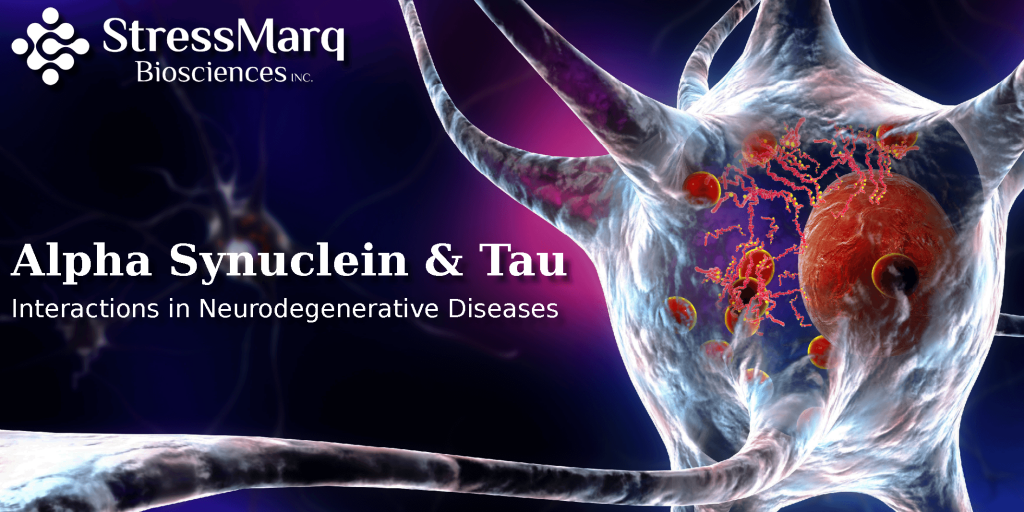Alpha Synuclein and Tau Interactions in Neurodegenerative Diseases
Alpha synuclein and tau are key proteins implicated in neurodegenerative diseases. Alpha synuclein aggregation into Lewy bodies is a pathological hallmark of Parkinson’s disease (PD) and tau aggregation into neurofibrillary tangles, along with amyloid-beta aggregation into plaques, is a hallmark of Alzheimer’s disease (AD). However, “synucleinopathies” and “tauopathies” often share features, and alpha synuclein and tau can interact in ways that promote each other’s aggregation.
Alpha Synuclein in Alzheimer’s Disease
AD is typically characterized by amyloid-beta plaques and tau neurofibrillary tangles. However, over half of AD patients’ brains were found to also contain Lewy bodies1 and high levels of alpha synuclein were found in AD patients’ cerebrospinal fluid (CSF).2 The role of alpha synuclein and Lewy bodies in AD is not well-understood. Lewy bodies can also exist in the brains of healthy subjects3 and it is possible they are pre-symptomatic or neuroprotective.4 It is possible that since AD involves disruption of protein homeostasis, the misfolding of aggregation-prone proteins such as alpha synuclein is a downstream effect of disease progression.5
Tau in Parkinson’s Disease
Neurofibrillary tangles can occur in sporadic PD6 and in Parkinson’s Disease Dementia (PDD).7
Alpha Synuclein and Tau Colocalization
It has been hypothesized that tangles and Lewy bodies do not co-occur by chance, but because tau and alpha synuclein, and amyloid-beta promote one other’s aggregation.10,11 Not only can neurofibrillary tangles and Lewy bodies coexist in the same disease state, but alpha synuclein and tau can also colocalize within these aggregates.8,9
How do Alpha Synuclein and Tau Interact?
Alpha synuclein can promote tau oligomerization12 and fibrillization.10 Conversely, tau can induce alpha synuclein aggregation.11,12 This can be seen in vitro and in mouse models – transgenic mice used to model advanced AD developed alpha synuclein inclusions despite not having an alpha synuclein transgene.15 Increased amounts of phosphorylated tau have also been seen in neurotoxin-induced16 and alpha synuclein overexpression mouse models of PD.17
How does alpha synuclein promote tau aggregation?
Alpha synuclein is thought to trigger tauopathies by reducing tau’s ability to stabilize microtubules.18 GSK3β may mediate this process, as it is thought to form a complex with tau and alpha synuclein, which then leads to tau phosphorylation.18 The negatively charged C-terminal region of alpha synuclein is thought to interact electrostatically with the positively-charged central region of tau, which could disrupt the interactions between tau and microtubules.14
How does tau promote alpha synuclein aggregation?
Interestingly, study shows that tau overexpression increases the number of alpha synuclein aggregates but decreases their size.13 This may account for enhanced alpha synuclein toxicity, since smaller fibrils are thought to be more toxic. The positively charged tau is thought to disrupt repulsive interactions between alpha synuclein proteins, which would enhance aggregation.14
It should be noted that amyloid-beta is likely also involved in these processes since it interacts with both alpha synuclein and tau.
StressMarq Products
StressMarq supplies a variety of alpha synuclein and tau fibrilized and oligomeric proteins and antibodies for neurodegeneration research. These include Human Alpha Synuclein Pre-formed Fibrils (catalog# SPR-322), which have been shown to successfully transmit from cell to cell. These can be used with Human Alpha Synuclein Monomers (catalog# SPR-321) for seeding fibril formation in vitro.
References
- Hamilton, R.L. “Lewy bodies in Alzheimer’s disease: a neuropathological review of 145 cases using alpha-synuclein immunohistochemistry.” Brain Pathology 2000, 10(3):378-84.
- Slaets, S. et al. “Increased CSF α-synuclein levels in Alzheimer’s disease: Correlation with tau levels.” Alzheimer’s and Dementia 2014, 10(5):S290-S298.
- Jellinger, K.A. “Lewy body-related alpha-synucleinopathy in the aged human brain.” J Neural Transm (Vienna) 2004, 111(10-11):1219-1235.
- Wakabayashi, K. “Lewy body formation in Parkinson’s disease: neurodegeneration or neuroprotection?” Rinsho Shinkeigaku 2008, 48(11):981-983.
- Kikis, E.A, Gidalevitz, T., Morimoto, R.I. “Protein homeostasis in models of aging and age-related conformational disease.” Adv Exp Med Biol 2010, 964:138-159.
- Joachim, D.L., Morris, J.H., Kosik., K.S., Selkoe, D.J. “Tau antisera recognize neurofibrillary tangles in a range of neurodegenerative disorders.” Ann Neurol 1987, 22:514-520.
- Irwin, D.J., Lee, V.M.-Y., Trojanowski, J.Q. “Parkinson’s disease dementia: convergence of α-synuclein, tau and amyloid-β pathologies.” Nat Rev Neurosci 2013, 14(9):626-636.
- Ishizawa, T., Mattila, P., Davies, P., Wang, D., Dickson, D.W. “Colocalization of tau and alpha-synuclein epitopes in Lewy bodies.” J Neuropathol Exp Neurol 2003, 62:389-397.
- Fujishiro, H., Tsuboi, Y., Lin, W.-L., Uchikado, H., Dickson, D.W. “Co-localization of tau and α-synuclein in the olfactory bulb in Alzheimer’s disease with amygdala Lewy bodies.” Acta Neuropathol 2008, 116(1):17-24.
- Giasson, Bl., Forman, M.S., Higuchi, M., Golbe, L.I., Graves, C.L., Kotzbauer, P.T., Trojanowski, J.Q., Lee, V.M. “Initiation and synergistic fibrillization of tau and alpha-synuclein.” Science 2003, 300(5619):636-40.
- Lee, V.M., Giasson, B.I., Trojanowski, J.Q. “More than just two peas in a pod: common amyloidogenic properties of tau and alpha-synuclein in neurodegenerative diseases.” Trends Neurosci, 2004, 27(3):129-34.
- Castillo-Carranza, D.L, Guerrero-Munoz, M.J., Sengupta, U., Gerson, J.E., Kayed, R. “α-Synuclein Oligomers Induce a Unique Toxic Tau Strain.” Biological Psychiatry 2018, 84:499-508.
- Badiola, N., de Oliveira, R.M., Herrera, F., Guardia-Laguarta, C., Goncalves, S.A., Pera, M., Suarez-Calvet, M., Clarimon, J., Outeiro, T.F., Lleo, A. “Tau Enhances α-Synuclein Aggregation and Toxicity in Cellular Models of Synucleinopathy.” PLoS ONE 6(10): e26609.
- Dasari, A.K.R., Kayed, R., Wi, S., Lim., K.H. “Tau Interacts with the C-Terminal Region of α‑Synuclein, Promoting Formation of Toxic Aggregates with Distinct Molecular Conformations.” Biochemistry 2019, 58:2814-2821.
- Chen, W. “Studying the Interactions Between Tau, Amyloid, and α-Synuclein in Alzheimer’s Disease Animal and Human Cell Models.” UC Irvine Electronic Theses and Dissertations
- Duka, T., Rusnak, M., Drolet, R.E., Duka, V., Wersinger, C., Goudreau, J.L., Sidhu, A. “Alpha-synuclein induces hyperphosphorylation of Tau in the MPTP model of parkinsonism.” Faseb J 2006, 20:2302–2312.
- Haggerty, T., Credle, J., Rodriguez, O., Wills, J., Oaks, A.W., Masliah, E., Sidhu, A. “Hyperphosphorylated Tau in an α-synuclein overexpressing transgenic model of Parkinson’s disease.” Eur J Neurosci 2011, 33(9):1598-1610.
- Carnwath, T., Mohammed, R., Tsiang, D. “The direct and indirect effects of α-synuclein on microtubule stability in the pathogenesis of Parkinson’s disease.” Neuropsychiatr Dis Treat 2018, 14:1685-1695.


Leave a Reply